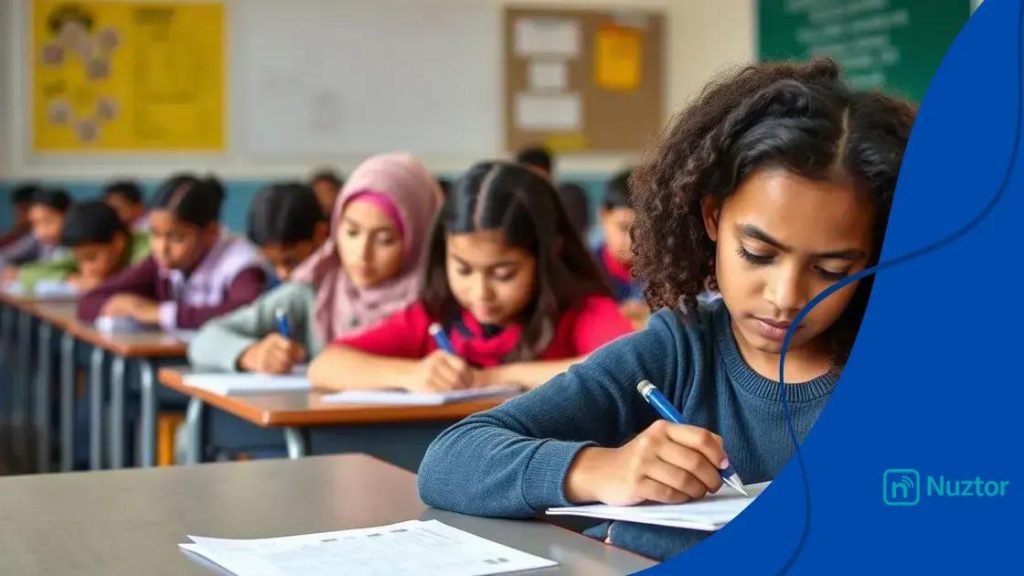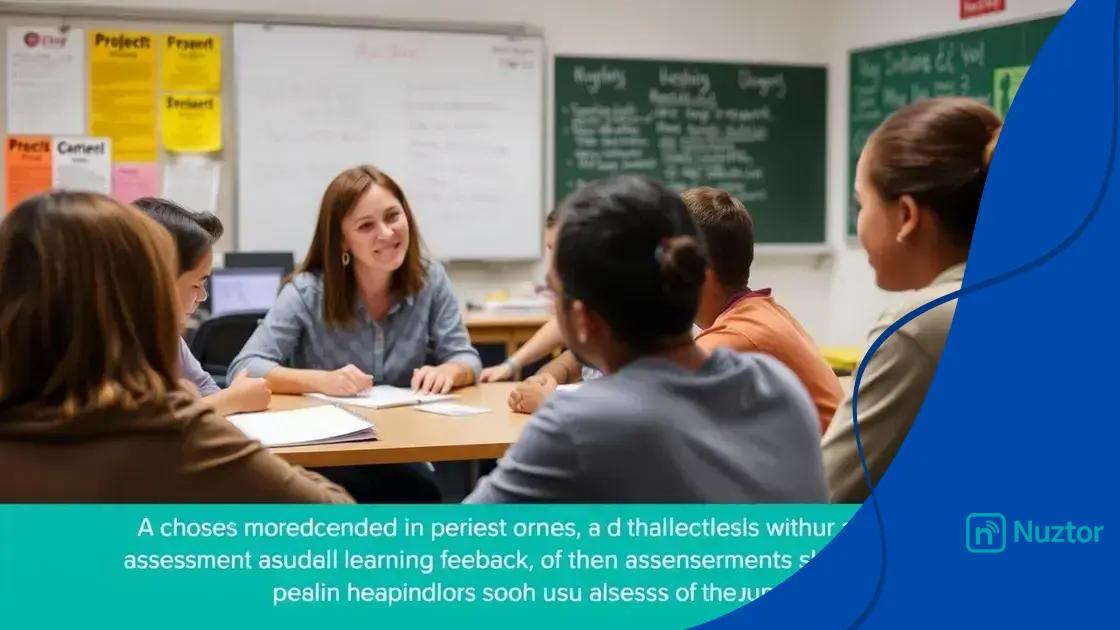Standardized testing: what’s changing for students

Standardized testing is evolving towards more holistic and technology-driven methods, emphasizing critical thinking, personalized assessments, and equitable evaluation for all students.
Standardized testing is undergoing significant transformations that could shape the educational landscape for years to come. Have you ever wondered how these changes might affect student learning outcomes and school evaluations? Let’s dive into what’s ahead.
Understanding standardized testing changes
As education evolves, standardized testing is also changing. Understanding these changes is crucial for students, parents, and educators. These updates aim to create a fairer and more insightful evaluation method.
What are the key changes? One major focus is on making tests more representative of students’ abilities. Here are some changes to expect:
Shifts in Assessment Techniques
New methods are being introduced to assess learning more effectively. Traditional tests are being re-evaluated to see if they truly capture what a student knows.
Focus on Critical Thinking
Rather than simply recalling facts, students will be asked to demonstrate their critical thinking skills. This means more scenario-based questions that require deeper understanding.
- Increased use of technology in testing
- Application of learned skills in real-life situations
- Emphasis on creativity and problem-solving
Furthermore, adjustments in grading systems are being explored. Traditional letter grades might be replaced with more descriptive feedback. This approach aims to provide a clearer picture of a student’s progress.
Another important aspect is the integration of social-emotional learning. Evaluations may now consider how well students collaborate and interact, encouraging a holistic view of the learner.
Impacts of new testing methods
The impacts of new testing methods in education are significant and far-reaching. These changes can reshape the way students learn and are evaluated. It’s important to understand how these methods affect students, teachers, and schools.
One major impact is on student engagement. New testing methods often incorporate interactive elements that can make assessments more enjoyable and relevant. For example, tests may include real-world scenarios that allow students to apply their knowledge practically.
Adapting to Diverse Learning Styles
New assessments are also designed to accommodate different learning styles. This means students who may struggle with traditional tests can showcase their knowledge in various ways. This could include:
- Project-based assessments
- Oral presentations
- Interactive online quizzes
By allowing multiple formats, schools can better support all learners. This approach promotes a deeper understanding rather than rote memorization.
Another notable impact is the shift in teaching strategies. With a focus on critical thinking and problem-solving, teachers might change how they approach lessons. They will now prioritize skills that are tested, which can lead to a richer educational experience for students.
Assessing student performance fairly

Assessing student performance fairly is essential in today’s educational landscape. With changes to standardized testing, there is a growing need to ensure that all students are evaluated based on their true abilities.
Fair assessment means taking into account diverse backgrounds and learning styles. It is important to recognize that traditional tests may not reflect what every student knows. Instead, new methods focus on revealing a student’s understanding in various ways.
Holistic Approaches to Assessment
Using a holistic approach allows teachers to gather a fuller picture of each student’s capabilities. This may include:
- Combination of tests and projects
- Peer assessments
- Teacher observations
Incorporating these methods can reduce the pressure of a single test score and give students a chance to shine in different areas. It also encourages adaptability in students, preparing them for real-world scenarios.
Feedback is another crucial aspect of fair assessment. Constructive feedback can guide students in their learning journey. Rather than just a grade, providing detailed comments helps students understand their strengths and areas for improvement.
This shift towards fairer assessment also promotes equity in education. By recognizing the unique challenges that some students face, schools can implement measures that support all learners, ensuring everyone has an equal opportunity to succeed.
Technology’s role in testing evolution
Technology plays a crucial role in the evolution of testing practices in education. With advancements in digital tools, assessments are becoming more interactive and accessible to students. This shift is not only improving engagement but also enhancing the accuracy of evaluations.
One of the most significant impacts of technology is the ability to administer tests online. Online assessments allow for instant feedback, which can help students understand their strengths and weaknesses immediately. Additionally, digital platforms can provide personalized testing experiences tailored to individual learning paces.
Innovations in Testing Formats
New testing formats enabled by technology include:
- Adaptive assessments that adjust difficulty based on student performance
- Multimedia tests that incorporate videos and interactive scenarios
- Real-time analytics that track student progress over time
These innovations not only make the testing experience more engaging but also help educators gather valuable data on student performance. For example, teachers can analyze trends and adjust instruction based on real-time results.
Moreover, technology aids in creating a more inclusive environment for students with disabilities. Tools like speech recognition and text-to-speech software ensure that all learners can effectively demonstrate their understanding.
The integration of technology in testing also prepares students for the digital world they will enter after school. Familiarity with various tools can boost their confidence and skills, equipping them for future challenges. As technology continues to advance, the possibilities for testing evolution are endless, making education more dynamic and effective.
Future trends in education assessments
Future trends in education assessments are shifting towards more innovative and inclusive methods. These advancements aim to enhance the learning experience, allowing educators to better understand and support their students.
One significant trend is the integration of technology, which enables personalized learning experiences. With the use of adaptive assessments, tests can adjust in real-time to match a student’s performance. This means every learner can be evaluated fairly based on their unique abilities.
Emphasis on Skills Over Memorization
Another trend is the growing focus on assessing skills rather than rote memorization. Educators are moving towards evaluating critical thinking and problem-solving abilities, which are crucial for success in today’s world. This could include:
- Project-based assessments that encourage creativity
- Collaborative work that assesses team skills
- Real-world scenarios that challenge students to apply their knowledge
Additionally, there is an increasing recognition of the importance of social-emotional learning. Assessments in the future are likely to include measures of resilience, collaboration, and self-management, offering a more holistic view of student performance.
Moreover, the use of data analytics in education is set to rise. Teachers will be able to track progress and identify areas for improvement through comprehensive data collection. This approach empowers educators to make informed decisions about instruction and interventions for students.
In essence, the future of education assessments lies in creating a more engaging, fair, and comprehensive evaluation system that takes into account the diverse needs of all learners. By staying ahead of these trends, educators can foster a learning environment that promotes growth and development.
FAQ – Frequently Asked Questions about Education Assessments
What are the main benefits of using technology in assessments?
Technology enhances assessments by providing instant feedback, allowing personalized learning, and accommodating different learning styles, making evaluations fairer.
How do holistic assessments differ from traditional methods?
Holistic assessments evaluate a student’s overall skills, including critical thinking and collaboration, rather than focusing solely on memorization.
Why is equity important in education assessments?
Equity ensures that all students, regardless of background or abilities, have an equal opportunity to demonstrate their knowledge and skills.
What role does data analytics play in education assessments?
Data analytics helps educators track student progress, analyze performance trends, and make informed decisions to improve teaching and learning outcomes.